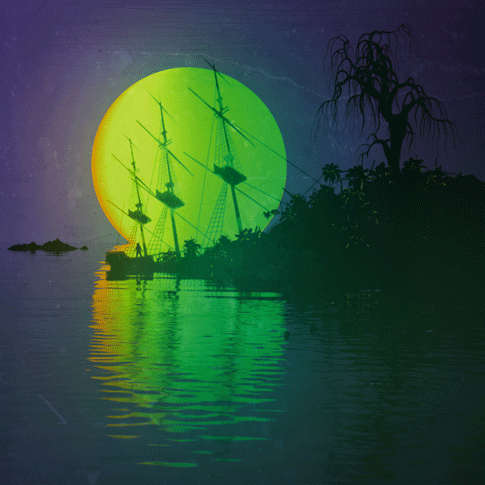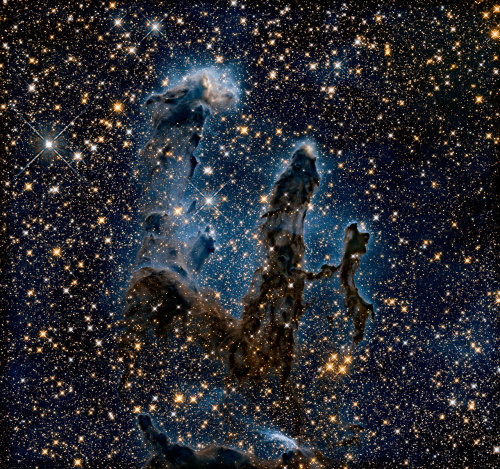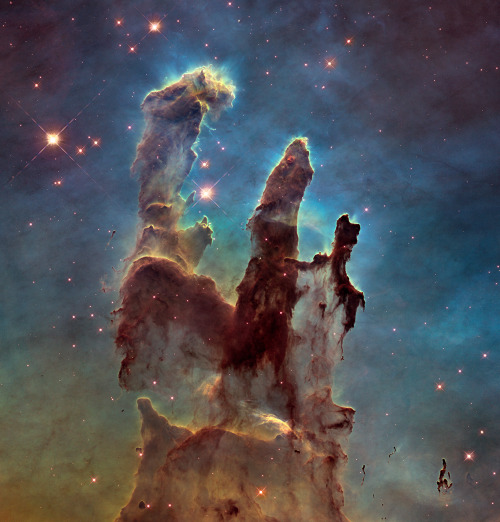“Lástima Que En Aquella época No Se Hubieran Descubierto Los Hoyos Negros En El Espacio, Porque Entonces
“Lástima que en aquella época no se hubieran descubierto los hoyos negros en el espacio, porque entonces le hubiera sido muy fácil comprender que sentía un hoyo negro en medio del pecho, por donde se le colaba un frío infinito.”
— Laura Esquivel, Como Agua Para Chocolate
More Posts from Luhuhul and Others

Launch and Landing : A composite of three consecutive exposures, this night skyscape follows the January 7 launch and first stage landing of a Falcon 9 rocket from a beach on planet Earth’s space coast. With the launch from Cape Canaveral Air Force Station, the bright streak beginning farthest left traces the initial phase of the rocket’s flight. A visible upward hook marks the first stage beginning its return trajectory with a “boostback burn” near the top of the arc, while the second stage separates and continues toward orbit. Above the top of the launch arc due to perspective, a bright streak shows the returning first stage slowing and descending toward the Cape. Centered below, the streak at the horizon is a 17 second burn finally slowing the first stage to a successful vertical landing about 8 minutes after launch at Landing Zone 1. During the scene’s effective long exposure time, the background stars leave short trails in the night sky of the rotating planet. via NASA

‘lost’
“Francamente, estaba horrorizado de la vida, de todo lo que un hombre tenía que hacer solo para comer, dormir y poder vestirse.”
Factótum, Charles Bukowski.


Sometimes… there’s more than meets the eye. 👀 You’re looking at two very different takes on an iconic image.
Human eyes can see only a small portion of the range of radiation given off by the objects around us. We call this wide array of radiation the electromagnetic spectrum, and the part we can see visible light.
In the first image, researchers revisited one of Hubble Space Telescope’s most popular sights: the Eagle Nebula’s Pillars of Creation. Here, the pillars are seen in infrared light, which pierces through obscuring dust and gas and unveil a more unfamiliar — but just as amazing — view of the pillars. The entire frame is peppered with bright stars and baby stars are revealed being formed within the pillars themselves. The image on the bottom is the pillars in visible light.
Image Credit: NASA, ESA/Hubble and the Hubble Heritage Team
Make sure to follow us on Tumblr for your regular dose of space: http://nasa.tumblr.com.

Geinrust farm in the watery landscape, 1905 - by Piet Mondrian (1872 - 1944), Dutch
Black Holes are NICER Than You Think!
We’re learning more every day about black holes thanks to one of the instruments aboard the International Space Station! Our Neutron star Interior Composition Explorer (NICER) instrument is keeping an eye on some of the most mysterious cosmic phenomena.

We’re going to talk about some of the amazing new things NICER is showing us about black holes. But first, let’s talk about black holes — how do they work, and where do they come from? There are two important types of black holes we’ll talk about here: stellar and supermassive. Stellar mass black holes are three to dozens of times as massive as our Sun while supermassive black holes can be billions of times as massive!

Stellar black holes begin with a bang — literally! They are one of the possible objects left over after a large star dies in a supernova explosion. Scientists think there are as many as a billion stellar mass black holes in our Milky Way galaxy alone!
Supermassive black holes have remained rather mysterious in comparison. Data suggest that supermassive black holes could be created when multiple black holes merge and make a bigger one. Or that these black holes formed during the early stages of galaxy formation, born when massive clouds of gas collapsed billions of years ago. There is very strong evidence that a supermassive black hole lies at the center of all large galaxies, as in our Milky Way.

Imagine an object 10 times more massive than the Sun squeezed into a sphere approximately the diameter of New York City — or cramming a billion trillion people into a car! These two examples give a sense of how incredibly compact and dense black holes can be.
Because so much stuff is squished into such a relatively small volume, a black hole’s gravity is strong enough that nothing — not even light — can escape from it. But if light can’t escape a dark fate when it encounters a black hole, how can we “see” black holes?

Scientists can’t observe black holes directly, because light can’t escape to bring us information about what’s going on inside them. Instead, they detect the presence of black holes indirectly — by looking for their effects on the cosmic objects around them. We see stars orbiting something massive but invisible to our telescopes, or even disappearing entirely!
When a star approaches a black hole’s event horizon — the point of no return — it’s torn apart. A technical term for this is “spaghettification” — we’re not kidding! Cosmic objects that go through the process of spaghettification become vertically stretched and horizontally compressed into thin, long shapes like noodles.

Scientists can also look for accretion disks when searching for black holes. These disks are relatively flat sheets of gas and dust that surround a cosmic object such as a star or black hole. The material in the disk swirls around and around, until it falls into the black hole. And because of the friction created by the constant movement, the material becomes super hot and emits light, including X-rays.
At last — light! Different wavelengths of light coming from accretion disks are something we can see with our instruments. This reveals important information about black holes, even though we can’t see them directly.

So what has NICER helped us learn about black holes? One of the objects this instrument has studied during its time aboard the International Space Station is the ever-so-forgettably-named black hole GRS 1915+105, which lies nearly 36,000 light-years — or 200 million billion miles — away, in the direction of the constellation Aquila.
Scientists have found disk winds — fast streams of gas created by heat or pressure — near this black hole. Disk winds are pretty peculiar, and we still have a lot of questions about them. Where do they come from? And do they change the shape of the accretion disk?

It’s been difficult to answer these questions, but NICER is more sensitive than previous missions designed to return similar science data. Plus NICER often looks at GRS 1915+105 so it can see changes over time.
NICER’s observations of GRS 1915+105 have provided astronomers a prime example of disk wind patterns, allowing scientists to construct models that can help us better understand how accretion disks and their outflows around black holes work.

NICER has also collected data on a stellar mass black hole with another long name — MAXI J1535-571 (we can call it J1535 for short) — adding to information provided by NuSTAR, Chandra, and MAXI. Even though these are all X-ray detectors, their observations tell us something slightly different about J1535, complementing each other’s data!
This rapidly spinning black hole is part of a binary system, slurping material off its partner, a star. A thin halo of hot gas above the disk illuminates the accretion disk and causes it to glow in X-ray light, which reveals still more information about the shape, temperature, and even the chemical content of the disk. And it turns out that J1535’s disk may be warped!

Image courtesy of NRAO/AUI and Artist: John Kagaya (Hoshi No Techou)
This isn’t the first time we have seen evidence for a warped disk, but J1535’s disk can help us learn more about stellar black holes in binary systems, such as how they feed off their companions and how the accretion disks around black holes are structured.
NICER primarily studies neutron stars — it’s in the name! These are lighter-weight relatives of black holes that can be formed when stars explode. But NICER is also changing what we know about many types of X-ray sources. Thanks to NICER’s efforts, we are one step closer to a complete picture of black holes. And hey, that’s pretty nice!
Make sure to follow us on Tumblr for your regular dose of space: http://nasa.tumblr.com.
Last night i saw declan mckenna and it was so fUn and i am crying

Star HD 14771 and spiral galaxy NGC 891 located in the andromeda constellation.
Credit: Laszlo Bagi
me checking in on my mutuals every day:

-
 stxpxdwxrld reblogged this · 4 years ago
stxpxdwxrld reblogged this · 4 years ago -
 stxpxdwxrld liked this · 4 years ago
stxpxdwxrld liked this · 4 years ago -
 el-sayo liked this · 4 years ago
el-sayo liked this · 4 years ago -
 feistycherry reblogged this · 4 years ago
feistycherry reblogged this · 4 years ago -
 rafitathor reblogged this · 4 years ago
rafitathor reblogged this · 4 years ago -
 nasty-cold liked this · 4 years ago
nasty-cold liked this · 4 years ago -
 little--black-submarine liked this · 4 years ago
little--black-submarine liked this · 4 years ago -
 blossomingseele liked this · 4 years ago
blossomingseele liked this · 4 years ago -
 lexyulianaa liked this · 4 years ago
lexyulianaa liked this · 4 years ago -
 ineverysensegeusaram reblogged this · 4 years ago
ineverysensegeusaram reblogged this · 4 years ago -
 ineverysensegeusaram liked this · 4 years ago
ineverysensegeusaram liked this · 4 years ago -
 itzel-venecia reblogged this · 4 years ago
itzel-venecia reblogged this · 4 years ago -
 monstereatshearts reblogged this · 4 years ago
monstereatshearts reblogged this · 4 years ago -
 inf0rmationflash liked this · 4 years ago
inf0rmationflash liked this · 4 years ago -
 blossomnani liked this · 4 years ago
blossomnani liked this · 4 years ago -
 jam-hair liked this · 4 years ago
jam-hair liked this · 4 years ago -
 pauaoi reblogged this · 4 years ago
pauaoi reblogged this · 4 years ago -
 pauaoi liked this · 4 years ago
pauaoi liked this · 4 years ago -
 non-signal reblogged this · 4 years ago
non-signal reblogged this · 4 years ago -
 vrrebol reblogged this · 4 years ago
vrrebol reblogged this · 4 years ago -
 moon-21-98 reblogged this · 4 years ago
moon-21-98 reblogged this · 4 years ago -
 ale-gorias liked this · 4 years ago
ale-gorias liked this · 4 years ago -
 failureofthesky liked this · 4 years ago
failureofthesky liked this · 4 years ago -
 luhuhul reblogged this · 4 years ago
luhuhul reblogged this · 4 years ago -
 miradasgrises liked this · 4 years ago
miradasgrises liked this · 4 years ago -
 eniweis-idontcare liked this · 4 years ago
eniweis-idontcare liked this · 4 years ago -
 cms1023 reblogged this · 4 years ago
cms1023 reblogged this · 4 years ago -
 mel-grosso liked this · 4 years ago
mel-grosso liked this · 4 years ago -
 peulepeulepeule liked this · 4 years ago
peulepeulepeule liked this · 4 years ago -
 valexquise liked this · 4 years ago
valexquise liked this · 4 years ago -
 el-amor-y-la-colera reblogged this · 4 years ago
el-amor-y-la-colera reblogged this · 4 years ago -
 el-amor-y-la-colera liked this · 4 years ago
el-amor-y-la-colera liked this · 4 years ago -
 sandyereyes reblogged this · 4 years ago
sandyereyes reblogged this · 4 years ago -
 poets-are-rigth liked this · 4 years ago
poets-are-rigth liked this · 4 years ago -
 sirenatornasol reblogged this · 4 years ago
sirenatornasol reblogged this · 4 years ago -
 sirenatornasol liked this · 4 years ago
sirenatornasol liked this · 4 years ago -
 murales-y-estrellas liked this · 4 years ago
murales-y-estrellas liked this · 4 years ago -
 cattleyaaa reblogged this · 4 years ago
cattleyaaa reblogged this · 4 years ago -
 cattleyaaa liked this · 4 years ago
cattleyaaa liked this · 4 years ago -
 artistaconinfinitosentimientos liked this · 4 years ago
artistaconinfinitosentimientos liked this · 4 years ago -
 rosana67 liked this · 4 years ago
rosana67 liked this · 4 years ago -
 moises-m-a-g liked this · 4 years ago
moises-m-a-g liked this · 4 years ago -
 kategath reblogged this · 4 years ago
kategath reblogged this · 4 years ago -
 kategath liked this · 4 years ago
kategath liked this · 4 years ago -
 non-signal liked this · 4 years ago
non-signal liked this · 4 years ago
